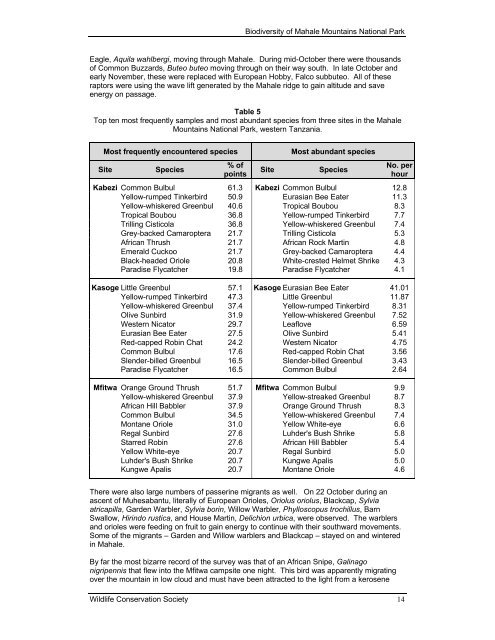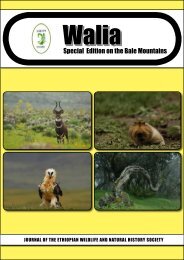Biodiversity of Mahale Mountains National Park, Tanzania | Report ...
Biodiversity of Mahale Mountains National Park, Tanzania | Report ...
Biodiversity of Mahale Mountains National Park, Tanzania | Report ...
You also want an ePaper? Increase the reach of your titles
YUMPU automatically turns print PDFs into web optimized ePapers that Google loves.
<strong>Biodiversity</strong> <strong>of</strong> <strong>Mahale</strong> <strong>Mountains</strong> <strong>National</strong> <strong>Park</strong><br />
Eagle, Aquila wahlbergi, moving through <strong>Mahale</strong>. During mid-October there were thousands<br />
<strong>of</strong> Common Buzzards, Buteo buteo moving through on their way south. In late October and<br />
early November, these were replaced with European Hobby, Falco subbuteo. All <strong>of</strong> these<br />
raptors were using the wave lift generated by the <strong>Mahale</strong> ridge to gain altitude and save<br />
energy on passage.<br />
Table 5<br />
Top ten most frequently samples and most abundant species from three sites in the <strong>Mahale</strong><br />
<strong>Mountains</strong> <strong>National</strong> <strong>Park</strong>, western <strong>Tanzania</strong>.<br />
Most frequently encountered species Most abundant species<br />
Site Species<br />
% <strong>of</strong><br />
points<br />
Site Species<br />
No. per<br />
hour<br />
Kabezi Common Bulbul 61.3 Kabezi Common Bulbul 12.8<br />
Yellow-rumped Tinkerbird 50.9 Eurasian Bee Eater 11.3<br />
Yellow-whiskered Greenbul 40.6 Tropical Boubou 8.3<br />
Tropical Boubou 36.8 Yellow-rumped Tinkerbird 7.7<br />
Trilling Cisticola 36.8 Yellow-whiskered Greenbul 7.4<br />
Grey-backed Camaroptera 21.7 Trilling Cisticola 5.3<br />
African Thrush 21.7 African Rock Martin 4.8<br />
Emerald Cuckoo 21.7 Grey-backed Camaroptera 4.4<br />
Black-headed Oriole 20.8 White-crested Helmet Shrike 4.3<br />
Paradise Flycatcher 19.8 Paradise Flycatcher 4.1<br />
Kasoge Little Greenbul 57.1 Kasoge Eurasian Bee Eater 41.01<br />
Yellow-rumped Tinkerbird 47.3 Little Greenbul 11.87<br />
Yellow-whiskered Greenbul 37.4 Yellow-rumped Tinkerbird 8.31<br />
Olive Sunbird 31.9 Yellow-whiskered Greenbul 7.52<br />
Western Nicator 29.7 Leaflove 6.59<br />
Eurasian Bee Eater 27.5 Olive Sunbird 5.41<br />
Red-capped Robin Chat 24.2 Western Nicator 4.75<br />
Common Bulbul 17.6 Red-capped Robin Chat 3.56<br />
Slender-billed Greenbul 16.5 Slender-billed Greenbul 3.43<br />
Paradise Flycatcher 16.5 Common Bulbul 2.64<br />
Mfitwa Orange Ground Thrush 51.7 Mfitwa Common Bulbul 9.9<br />
Yellow-whiskered Greenbul 37.9 Yellow-streaked Greenbul 8.7<br />
African Hill Babbler 37.9 Orange Ground Thrush 8.3<br />
Common Bulbul 34.5 Yellow-whiskered Greenbul 7.4<br />
Montane Oriole 31.0 Yellow White-eye 6.6<br />
Regal Sunbird 27.6 Luhder's Bush Shrike 5.8<br />
Starred Robin 27.6 African Hill Babbler 5.4<br />
Yellow White-eye 20.7 Regal Sunbird 5.0<br />
Luhder's Bush Shrike 20.7 Kungwe Apalis 5.0<br />
Kungwe Apalis 20.7 Montane Oriole 4.6<br />
There were also large numbers <strong>of</strong> passerine migrants as well. On 22 October during an<br />
ascent <strong>of</strong> Muhesabantu, literally <strong>of</strong> European Orioles, Oriolus oriolus, Blackcap, Sylvia<br />
atricapilla, Garden Warbler, Sylvia borin, Willow Warbler, Phylloscopus trochillus, Barn<br />
Swallow, Hirindo rustica, and House Martin, Delichion urbica, were observed. The warblers<br />
and orioles were feeding on fruit to gain energy to continue with their southward movements.<br />
Some <strong>of</strong> the migrants – Garden and Willow warblers and Blackcap – stayed on and wintered<br />
in <strong>Mahale</strong>.<br />
By far the most bizarre record <strong>of</strong> the survey was that <strong>of</strong> an African Snipe, Galinago<br />
nigripennis that flew into the Mfitwa campsite one night. This bird was apparently migrating<br />
over the mountain in low cloud and must have been attracted to the light from a kerosene<br />
Wildlife Conservation Society 14
















